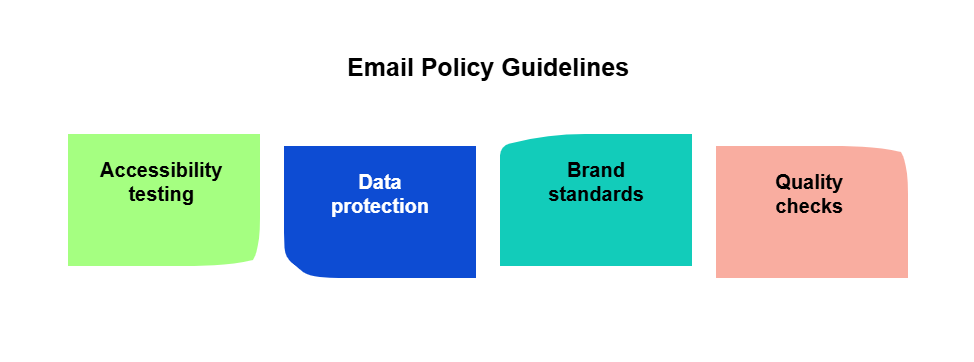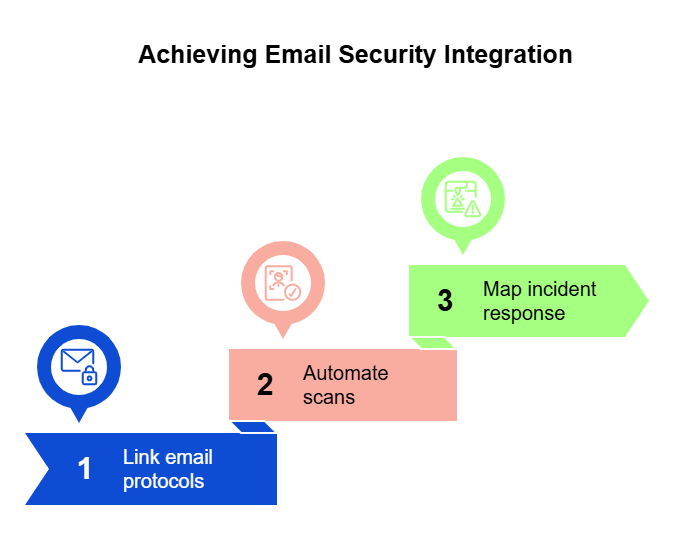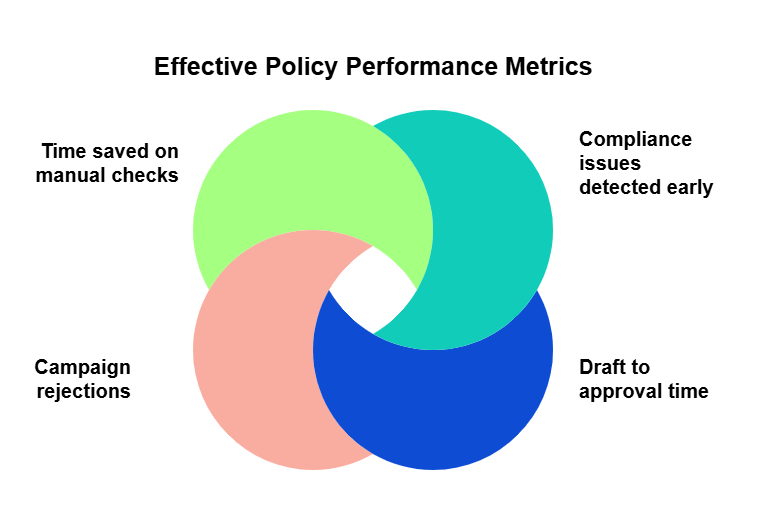Email compliance made easy: A marketer’s guide to stress-free campaigns
It’s time to jettison manual checks for accessibility and brand voice and go for the gold with automation.
- By Saphia Lanier - Apr 02, 2025
Your email content is polished and ready. After three rounds of revisions (and a thorough email marketing audit from the creative team) you're about to send it to your email list of 50,000 subscribers. Then it happens . . . someone notices your email list includes subscribers from multiple countries, triggering mandatory compliance checks. Your European subscribers fall under GDPR requirements, so legal needs to review everything. Suddenly, your perfectly timed email sequence is stuck in limbo.
For many marketers, email marketing compliance raises constant questions and second-guesses. Between accessibility requirements, email security protocols, and guidelines for handling sensitive information, a single mistake in email communication can damage customer trust, trigger fines, and hurt your brand's reputation.
Thankfully, maintaining email deliverability and compliance doesn't have to be complicated. Today’s tools, like Email Governance, automatically validate your email compliance checklist while you work, not after you hit send.
This guide shows you how to:
- Build email policies that protect without restricting creative email content
- Set up automated checks that catch compliance issues early
- Align your email communication with legal requirements and brand standards
- Turn email marketing compliance from a bottleneck into a competitive advantage
Your path to confident, compliant email messages starts here.
Why every email policy needs a purpose statement
Bad emails cost money. One violation of email compliance regulations can torpedo months of careful brand building, whether it's a compliance fine, lost customers, or a PR nightmare. A solid policy stops these expensive mistakes before they happen.
Nobody spots issues at the perfect time. You're minutes from sending when legal discovers you've been collecting location data without explicit consent, or that your unsubscribe process requires three clicks instead of one clear button, both of which run counter to GDPR (General Data Protection Regulation). Or a customer with a huge following discovers your emails aren't accessible with screen readers, and now your brand's all over X for the wrong reasons.
A purpose statement defines exactly what your email policy aims to achieve. It's a clear declaration that guides every rule and requirement you create.
For example, your purpose statement might read: "This policy ensures all marketing communications meet accessibility standards, comply with data protection laws, and maintain brand consistency." Now your team knows precisely what standards matter and why they exist.
A practical email policy sets clear rules for:
- What your accessibility testing must cover
- How customer data stays protected
- When brand standards apply
- Which quality checks matter most

Smart policies need smart tools. Platforms like Email Governance catch problems while you write, so you never have to explain to your boss why that perfectly timed product launch sits in legal review.
Accessibility standards that actually work
Web Content Accessibility Guidelines (WCAG) — the global standard for digital accessibility — sound scary until you break them down. Your policy should spell out exactly what teams check: proper heading structure, alt text that makes sense, color contrast that works for everyone. No legal jargon: just clear steps that keep your emails accessible.
Data protection without the panic
GDPR, CCPA, and other emerging privacy regulations demand careful customer data handling. Instead of getting lost in GDPR compliance documents, create clear, actionable guidelines. Write policies that tell teams exactly how to manage personal information, handle opt-ins, and track data across campaigns.
Brand standards made clear
"Please follow brand guidelines" doesn't cut it. Detail which elements need review, who signs off, and what happens when someone goes rogue. Clear processes beat vague requests every time.
Quality control that catches problems
Surprise issues make everyone look bad. Define specific quality benchmarks and set up systematic checks that spot problems while you can still fix them. Automated tools validate compliance during content creation, before your send date approaches.
Clear rules and smart technology free your team to write compelling emails while preventing legal-related campaign delays.
Build a detailed email policy
Most email policies miss the mark — too vague to follow, too boring to read, and too disconnected from daily marketing reality. A policy needs three specific components that establish proper quality assurance and brand consistency.
1. Accessibility standards
Screen readers can't interpret your clever design if you skip proper heading structure. Alt text like "banner_v3_final.jpg" helps exactly no one. Color contrasts need specific ratios, not subjective judgment calls about what looks "fine." Your policy should spell out exactly what accessibility means.
Email Governance catches these issues while you work. Missing alt text? Flagged. Poor heading structure? Identified. Unreadable color combinations? Spotted before a single subscriber complains.
2. Quality benchmarks
"Ensure quality" ranks among the most useless instructions ever written. Quality means specific things: email security protocols that protect your audience, HTML that renders in every major email client, and readability that matches your audience. Your policy should define these benchmarks with precision.
When Email Governance spots quality issues during creation, you can fix them in seconds. No more frantic corrections after complaints start rolling in. The system catches broken links, formatting problems, and rendering issues before they reach a single inbox.
3. Brand guidelines
Nobody reads that 30-page brand manual. Your email policy needs clear, specific guidelines: exact color codes for your brand palette, required trademark symbols, approved logo placement, and voice standards that leave no room for creative interpretation.
Email Governance validates these elements automatically against your requirements. No more subjective debates about whether something "feels on-brand" — just clear yes/no validation against established standards.
These three components of an email marketing policy turn forgotten policy PDFs into useful daily standards. Your marketing team writes better emails because they catch mistakes at 9 a.m. during drafting, not at 4:55 p.m. when Legal suddenly flags issues. Specific standards mean faster approvals, fewer emergency fixes, and no more explaining to your boss why another campaign missed its deadline.
Integrate email security into your company-wide strategy
Most email policies sit in isolation. Yours shouldn’t. Connect it to your company's security system and watch it become more effective. Every marketing email you send contains customer insights, campaign data, and product information that needs serious protection.
Your security system should work like a meticulous archivist: It should tracke access, manage permissions, and enforce deletion schedules with precise attention to detail. This matters even more if your team crafts campaigns from their living rooms, local cafes, and everywhere in between. Distance shouldn't diminish protection.
Email Governance steps up to this challenge. It spots suspicious links and blocks malware before they touch your inbox. It translates complex GDPR, HIPAA, and CCPA requirements into automatic checks. The AI component monitors patterns and flags unusual behavior so you can catch issues early.
Turn this into reality with three clear steps:
- Link your email protocols to security systems
- Activate automatic compliance and security scans
- Map out clear incident response steps

Skip the marathon training sessions. Give your team brief updates and practical guides they'll use. Simple, clear protocols beat complex rulebooks every time.
Let automation (aka Email Governance) handle the security checks while your team focuses on compelling campaigns. When auditors review your process, they'll see your email security goes beyond policies on paper.
Turn email rules into daily habits
Writing a policy means nothing if your team ignores it. Most policies fail at implementation because they disrupt workflows, create bottlenecks, and send teams searching for workarounds.
Here's how to make yours stick.
Start with your existing workflow
Don't force teams to learn new processes. The best policy fits into how people already work. Email Governance plugs directly into popular marketing platforms, checking email addresses and content while teams write. No extra steps, no platform switching, no workflow disruption.
Automate the boring parts
Manual compliance checks waste time. Nobody wants to verify every image has alt text or check if each link works. Email Governance handles these tasks automatically, flagging issues as they appear. Your team can focus on writing great emails while the system ensures everything meets standards.
Skip the resistance phase
Teams resist new policies for one reason: They slow work down. But what if your policy actually helped people work faster? Email Governance catches issues during creation, when fixes take just seconds. No more last-minute scrambles or emergency reviews.
Measure what matters
Skip vanity metrics. Track specifics that show your policy works:
- How many compliance issues get caught during creation vs. final review
- Average time from first draft to approved campaign
- Number of campaigns rejected for compliance issues
- Time saved on manual checks

Real numbers prove your policy helps rather than hinders. When teams see their work improving and moving faster, they'll want to follow the rules.
Teach smart habits, not boring rules
Most email training sessions put people to sleep. PowerPoint slides about regulatory compliance bore teams into ignoring everything you just taught them. Skip the three-hour policy lectures. Instead, show teams exactly how Email Governance prevents problems and speeds up their work.
Here's how to do it:
- Run focused 30-minute sessions on specific tools
- Use real examples from your team's campaigns
- Show immediate fixes for common issues
- Let teams practice with their actual work
- Demonstrate real-time feedback features
- Track specific improvements, not vanity metrics
What happens when training works? Teams spot accessibility issues while writing. They catch broken links before testing. They validate brand standards in real time. Each prevented error and faster approval cycle proves the value of proper training.
When training clicks, email compliance becomes second nature. Your team spots issues early, fixes problems fast, and sends campaigns with confidence. No more dreading legal reviews or scrambling to fix last-minute problems. Just better emails, sent on time, every time.
Monitor and enforce email policies on cruise control
Random spot checks don't catch email marketing compliance issues. By the time someone notices a problem, thousands of subscribers have already seen it. Email Governance watches every campaign automatically, flagging potential issues before a single email goes out.
Here's how automated monitoring prevents compliance nightmares:
- Scans every email draft for accessibility barriers
- Checks links, images, and HTML in real time
- Validates brand elements against your standards
- Spots policy violations during content creation
- Alerts teams to fixes needed before sending
- Documents compliance status for every campaign
Want to know the real cost of missed compliance checks? Ask the company that sent 50,000 emails with broken unsubscribe links. Or the team whose inaccessible campaign triggered ADA complaints. Or the brand that mixed up merge fields and exposed customer data. Email Governance catches these issues during creation, when fixes take minutes instead of causing PR crises.
Every email gets the same thorough review, whether you're sending ten messages or ten thousand. More importantly, your marketing team keeps their creative momentum by fixing small issues early instead of facing major revisions after legal review.
Stop fixing email compliance errors, start preventing them
We know the email compliance challenges you face daily: Legal reviews that delay time-sensitive campaigns. Accessibility issues discovered after sending. Brand standards that slow down creative work. Manual checks that eat up hours of productive time.
Siteimprove’s Email Governance solution solves these problems at the source.
It catches compliance issues during content creation, validates accessibility requirements automatically, and ensures brand standards without manual reviews. Your team writes better emails faster because they spot potential problems when fixes take seconds instead of hours.

